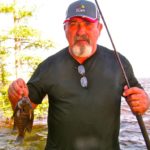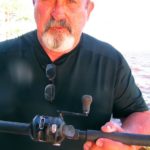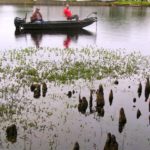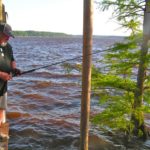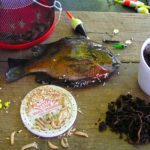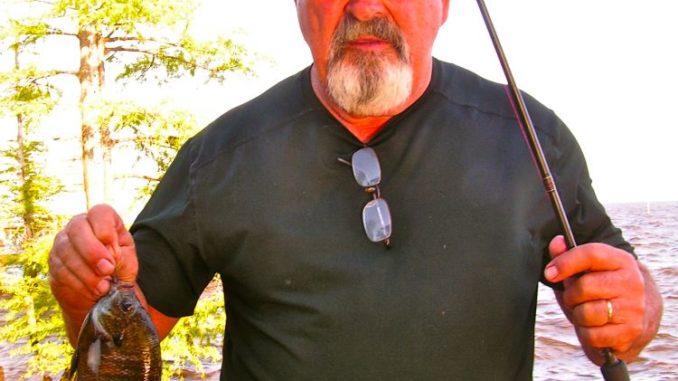
June offers fishermen “lights out” fishing action!
Randy Tucker lives less than 50 feet from a 16,000 acre lake busting at the seams with 2-pound crappie and lots of 6- to 8-pound bass. So what does he do when he gets ready to go fishing?
“I go bream fishing,” says the long-time Farmerville resident. “That’s all I do. I love it. Always have. I’ve never done anything else.”
Randy has a logical explanation.
“I’m a Type A personality and I’m going wide open 99.9% of the time,” he says. “Bream fishing is like a sedative for me. It’s relaxation. It’s a time I don’t have to think about anything else. I just sit there and watch that cork go under. I’m at peace and at ease. It’s very serene. And, I love to eat them. I scale them and fry them whole. That’s also the only way I’ve ever done it.”
To Tucker, summer means it’s time to catch bream.
“The bream usually start getting on the beds and bunching up when the water temperature gets around 68-75 degrees, and that’s when it’s easiest to catch them, especially in numbers,” he says. “I start looking for chinquapins first, then the bluegills are a few weeks later.”
Having lived on Lake D’Arbonne since 1972, Tucker doesn’t have to do a lot of looking to find bedding bream. He starts right on his own boat dock. When the fish start moving in there, he knows to go start looking at his favorite spots around the lake; they are moving onto them at the same time.
“Bream are creatures of habit this time of year. Through the years, the same spots almost always produce,” he adds. “I have noticed that there are some changes in D’Arbonne, though. The new tainter gates that they have installed drain the lake faster when it is about to flood and I think that has changed the bottom in some areas. Where fish were bedding in 3-4 feet of water, they may be in 5-6 feet of water, but close to the same spots. Keep that in mind when fishing here.”
Tucker says it’s hard to say exactly what to look for as far as structure goes when searching for bedding bream. He has studied the lake when it has been drawn down and says there are bream beds in places he has no idea why they would be there. Then some areas that should be holding bream just don’t. In other words, you can’t get locked in on a certain type of tree, bank or bottom type all the time.
But there are things you can look for.
“First of all, stick to the shallower areas of whatever lake you are fishing. Always look for bubbles. As you are fishing, keep your eyes on the surface of the water and look for small bubbles,” he says. “That will be a bed of bream. All the activity keeps bubbles stirred up. They won’t be constant, but they are a tell-tale sign of bedding bream. The second thing I rely on is smell. Some people laugh, but when you are close to a big bed of bluegills, you can actually smell a fishy odor in the air. Don’t laugh. I’m not kidding.”
His best bet for catching bedding bream is very important.
“Bream are very skittish when they are on the beds,” Randy says. “Don’t run your boat up in the shallow water where they are. Stay out and cast your bait up to them. Don’t make a lot of noise. Sometimes if you plop your cork in a spot too loudly, it will spook them. And if you catch a couple and drag them through the bed, expect the fishing to slow down for 10 minutes or so because it will scatter them. You may catch five or 10 and then if they quit, that’s what happened.”
As far as equipment, Randy uses either a 10-foot fiberglass rod with a straight line and cork, or he fishes a 5- to 6-foot rod with a closed-face reel when he is casting to the fish. He does swear by the Zebco Omega Pro Spincast Reel. He says he often catches up to 1,500 bream each summer and it holds up to that kind of pressure.
Randy’s top spot for bream is obviously in his backyard on D’Arbonne. But he also loves to fish Bayou DeLoutre, Ouachita River lakes and several other bodies of water in the area. Some top areas to bream fish are listed elsewhere in this article.
Pick one and give it a try. Randy offers one other piece of advice that you can’t argue with.
“You can’t catch them unless you go,” he says.
The best of the best
Randy Tucker starts his list of favorite northeast Louisiana June bream spots right in his own back yard at Lake D’Arbonne. “It’s too convenient for it not to be No. 1”, he says. Here are some of his favorites and some others you should try this summer:
Lake D’Arbonne at Farmerville – Shorelines and shallow flats are best spots here. Bream bed near boat docks and cypress or tupelo gums on the big lake and near the shore up D’Arbonne and Corney creeks. A depthfinder is helpful to find shallow flats in the middle of the lake. Look for duck blinds. They will be in two-three feet of water no matter how far out from the bank.
Black Bayou Lake at Monroe – Finding bream in this 2,000-acre cypress-studded lake may be easier than finding your way back to the boat dock in this lake. Fish around open spots in the grass near cypress. The old railroad track area on the West side of the lake always produces.
Ouachita River lakes – Randy usually fishes from Alabama Landing north and hits the lakes and bayous. Fishing is especially good while the river is still backed up in the lakes. But there are river lakes all the way down to Riverton Lake near Columbia that produce good bream catches. Grab a map, find the nearest launch and give one a try. Fish the backs of the lakes around trees, look for old road beds or fish tops near the mouth of the lakes. The river runs all the way from the Arkansas line to below Columbia — more than 100 miles.
Bayou DeLoutre near Marion – This meandering little stream is tough to get into. Access for small boats is available at several bridges or you can reach much of it from the Ouachita River. It is full of giant old cypress trees and stumps and isn’t very wide in most places. Fish the grass beds, old runouts or around the bank. Stay away from areas with current when targeting bream.
Turkey Creek Lake at Wisner – This is one of the most productive areas in the state for bream because of the stumps and heavy cover. Duckweed and vegetation can be a summer problem, but find the holes in it for bedding bream. There are 3,000 acres to search. Look for shallow water near the shore as well.
Lake Claiborne at Homer – Bream fishermen are usually up the creek here, as in Hurricane Creek, Beaver Creek, and Allen Creek. Fish the banks and the cypress trees up the arms of the lake. Also the grassbeds near piers and points. Stay in marked boat lanes — it’s stumpy up in there.
Caney Lakes at Minden – Yes, there is more than one. Upper and Lower Caney Lakes are part of the Kisatchie National Forest near Minden. The 250-acre lakes are one of the best kept fishing secrets in the area. They are small, in the middle of nowhere and offer fine fishing and easy access. They are great for smaller boats. Most of the best bream fishing is off the small points or in the coves. Shhh…don’t tell anybody.
Poverty Point at Delhi – Big bass and crappie grab spring headlines, but bream grab the summer spotlight here. Fish around the banks and in the numerous chutes. There are also areas, especially around the park, where you can fish from the bank with success. Don’t pass up the rocky areas, especially around camps and boathouses.
Lake Providence at Lake Providence – Yes, the 1,380 acre oxbow lake and the town have the same name. The five-mile long lake has a cypress tree studded shoreline and numerous wooden boat docks and piers that offer great bream bed possibilities. Try the Baxter Point and the Tensas Basin areas of the lake as well.
A pond near you – This region is dotted with ponds and small lakes. Many are in public areas, but most are on private land or hunting club leases. If you find out who the landowner or lease holder is, ask permission, promise to leave things better than you found them and follow the owner’s wishes in keeping or releasing fish. You can probably get permission, especially if you are taking kids fishing. Give it a try.
